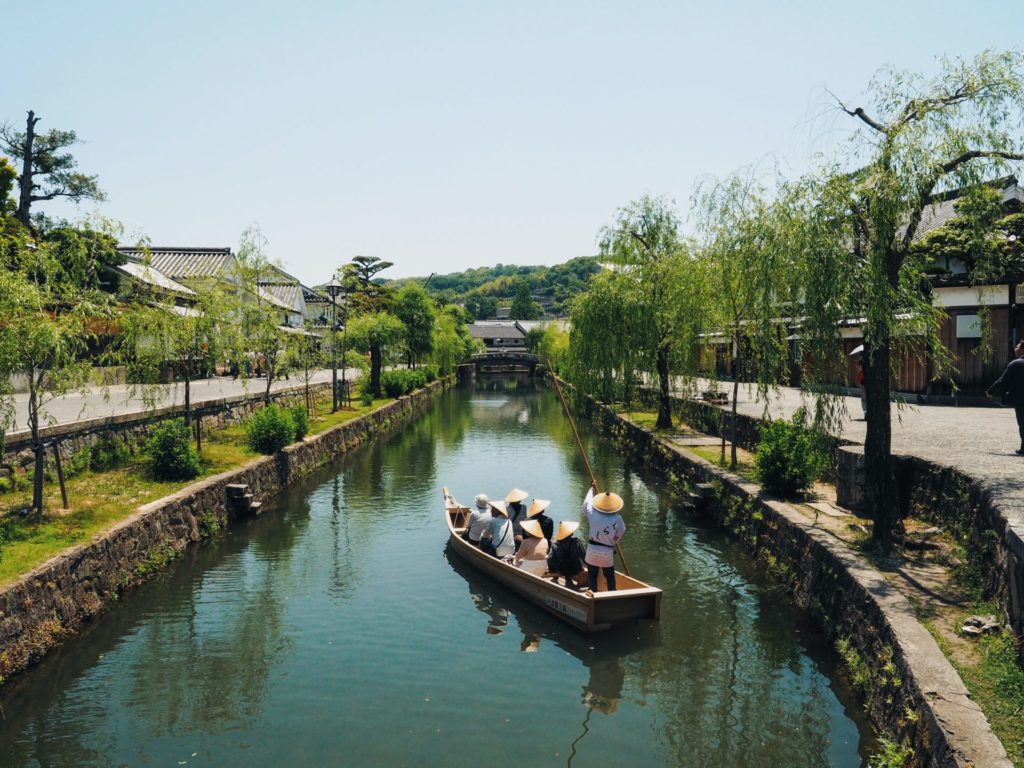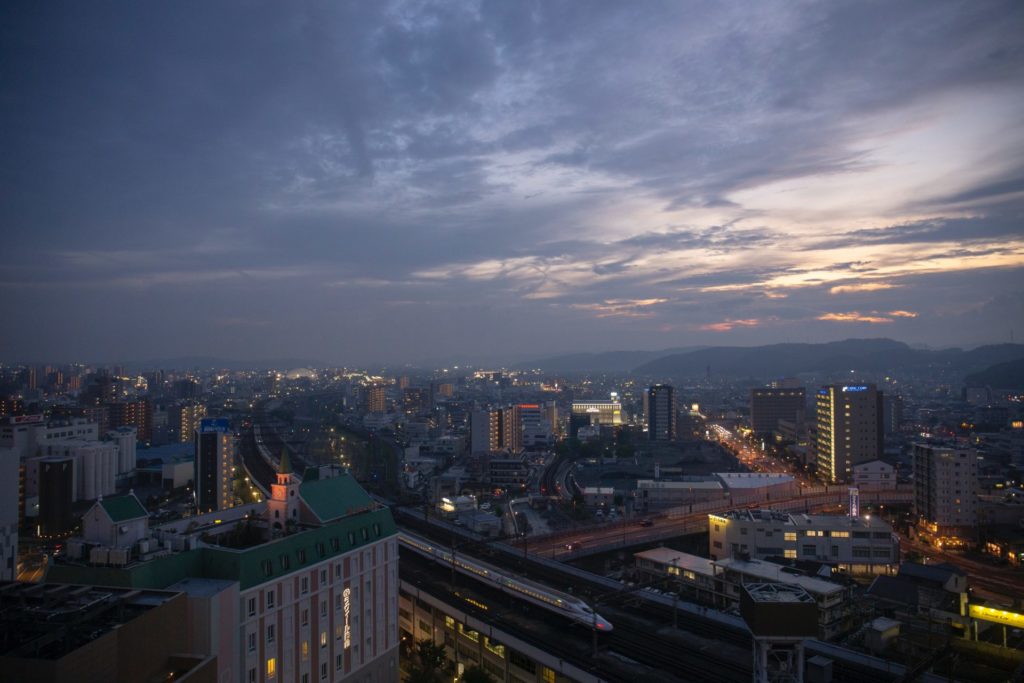Quick Bites: Kakigōri, the Sweet Taste of Summer
Top Image: Kentaro Toma on Unsplash
Shaved ice is a dessert enjoyed the world over. While the earliest known example of it can be traced back to ancient Rome, it is the version that originated in Japan which spread across the world and became a treat enjoyed by all during the warmer parts of the year.
Kakigōri (かき氷) is the traditional Japanese way of making a shaved ice dessert. It is commonly flavored with various fruit syrups such as strawberry, melon, lemon, cherry, blue raspberry, yuzu, sweet plum, and grape. Kakigōri tends to have a crunchier texture than other kinds of shaved ice, instead boasting a soft, light and fluffy feeling that melts in the mouth like freshly fallen snow.
The origins of kakigōri date back the Heian period in Japanese history, where it was considered a delicacy and not accessible to the common folk. During the summer, blocks of ice saved during the colder months would be shaved and served with sweet syrup to the aristocracy. Kakigōri’s origins are even referred to in Sei Shōnagon’s The Pillow Book, a book of observations written by the Imperial courtesan and poet.
Kakigōri became more widely accessible during the Meiji period around the 19th century, when advancements in technology made ice more available to the public during the summertime. Before then, ice was still quite expensive, as people had to import what was called “Boston Ice” from the US. Transporting could sometimes take up to half a year.
A food entrepreneur named Kahe Nakagawa successfully delivered “Hakodate Ice'” from Hokkaido to Yokohama, and within a few years the first kakigōri store opened in the Kanagawa area.
Further advancements such as the invention of an ice-shaving machine in the 1930’s helped kakigōri transition from a privilege of the ruling class to something that could be enjoyed by all. July 25th is even known as Kakigōri Day in Japan because of its pronunciation sounding similar to ‘summer ice’ in Japanese. Another reason for the date is that July 25th 1933 recorded record high temperatures in Japan, and kakigōri was the perfect way to beat the heat.
Preparation for kakigōri could not be more simple. First, prepare the flavored syrups and other toppings you want- fresh fruit, cream, sweetened red beans or tapioca are all popular. Second, using an ice-shaving machine to grind down the ice into an edible form. Finally, serve your shaved ice with your choice of fruit syrup and other toppings. And after that, eat it immediately and cool down!
One final point of interest: if you want to try something new with your kakigōri, why not partake in Shirokuma (白熊 or しろくま) a dessert made using kakigōri shaved ice but flavored with condensed milk, small colorful mochi, fruits, and sweet bean paste (usually Azuki bean). Mandarin oranges, cherries, pineapples, and raisins are also often used. A popular treat in Kagoshima for centuries, it’s a personal recommendation from us here at MUSUBI!
Photo Credits:
Top Image: Kentaro Toma on Unsplash
All other content (text) created by the original author and © 2021 MUSUBI by Borderlink
“It’s one of those fleeting moments in your life that your mind may forget but
your heart won’t.”
If I were to break down my experience here into three words they’d be: starry, realistic and futuristic. I can still feel the velvety touch of the soft round pillow where my head rested during the experience and the different constellations surrounding me, paralyzing my senses with their beauty.
It is in Yurakucho, Tokyo that you will find Japan’s first full dome theater complex named ‘The Planetaria Tokyo’. It is one of three theaters directly managed by Konica Minolta Planetarium, which is a manufacturer of Planetarium technologies. From projection mapping of starry night skies to highly immersive audio—this is truly a one-of-a-kind experience. Not only this, they also teamed up with voice recording artists to narrate and give life to their visions of night skies.
Planetaria Tokyo is divided into three different areas, simply named Dome 1, Dome 2 and Virtual Link Theater. Each of these areas has a special function that suits the audience’s unique tastes. The most unique one for me is their Virtual Link Theater, which offers an outer space experience for its audiences. You will have to take a seat in a cocoon-shaped VR chair and put on some VR glasses which show you the real night skies.
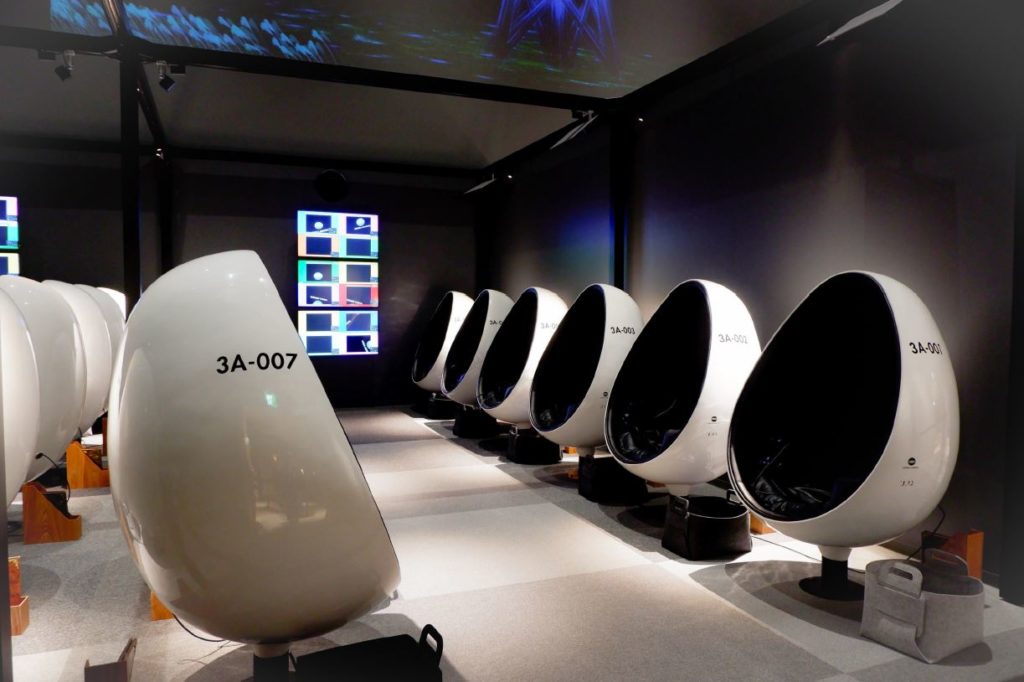
Then there is Dome 1 or the ‘Multi-purpose Digital Dome Theater’, which is offers an 8K Resolution show that seeks to create the experience of the “Future” for the audience. The Dome’s tech is capable of floor-to-ceiling projection mapping— making the audience feel like they are literally floating in outer space. This dome is also used for live musical performances and ‘night talks’ where the audience may enjoy their favorite artists or speakers while availing themselves of the theater’s refreshments.
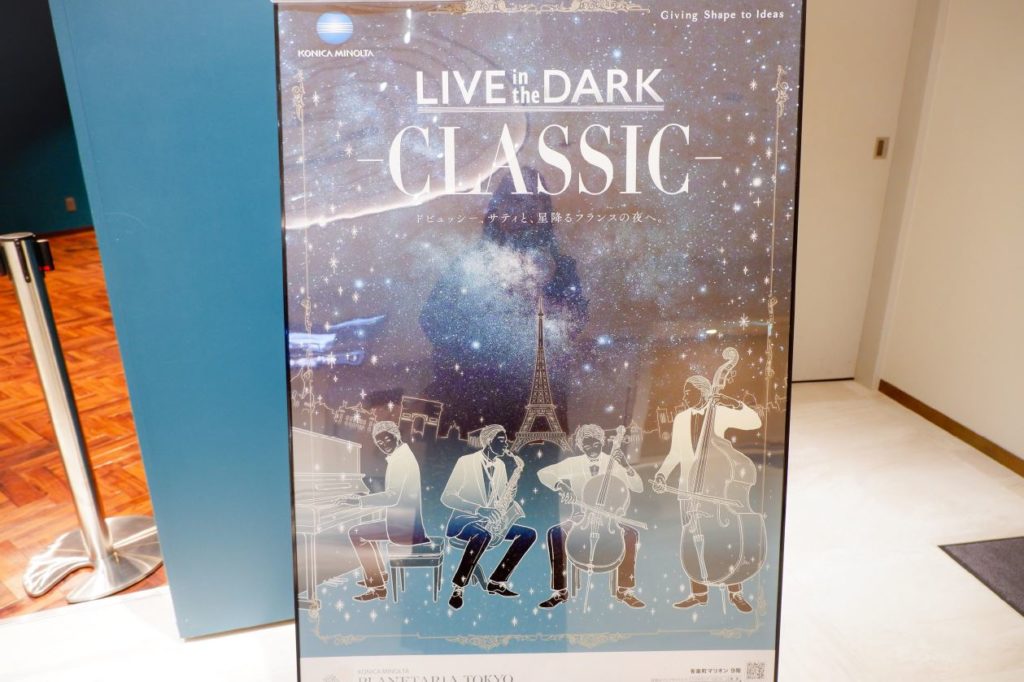
Finally, there is Dome 2, also called as ‘Planetarium Dome Theater’ where we watched the “Starry Night in France”. A show that details the odyssey of Antoine de Saint-Exupéry — the author and creator of The Little Prince. Along with this, they also showed other stories that took place under the Starry Parisian Skies. I revisited to stories of Cassiopeia, Cepheus and Andromeda.
I toured the city of Leon (among others) and allowed myself to be lulled by a tantric melody while gazing at the stars and the view of the night skies over Paris. It was heartwarming and interactive— as if for a moment we were all heavenly bodies suspended in space — gazing upon the chaos and beauty of the human realm.
My favorite part was towards the end of the show where the narrator asked us all to relax and moved on to play a bittersweet violin piece— suddenly all the projectors were turned off and it was all just darkness around us. Then little by little the starts started appearing, culminating with a beautiful view of the Milky Way galaxy.
As I gazed around me I could see a lot of people holding hands— families, couples, a mother and her child. It was truly beautiful and created a special bond with whoever you were with at that moment. I’d swear it was the perfect place for a love confession or a marriage proposal. And all of this was done through a combination of the Cosmo Leap II — Konica Minolta’s newest projector — and Sound Dome technology.
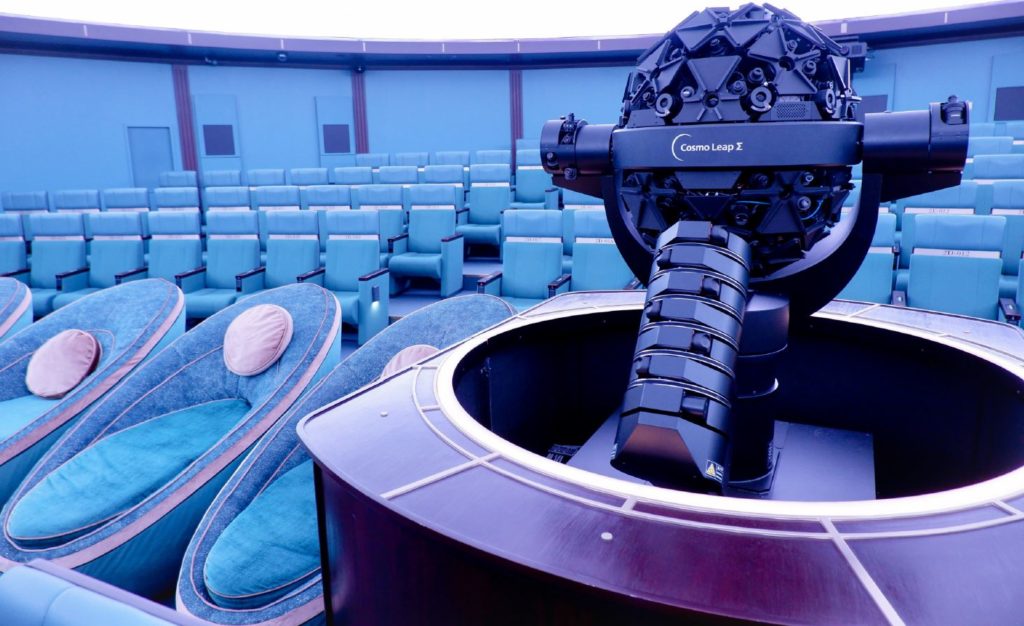
The shows were also narrated in English and Chinese for those who can’t understand Japanese— all you have to do is inform the staff and borrow a special ear piece at the entrance of the dome. The staff will also assist you in setting it up before the beginning of the show.
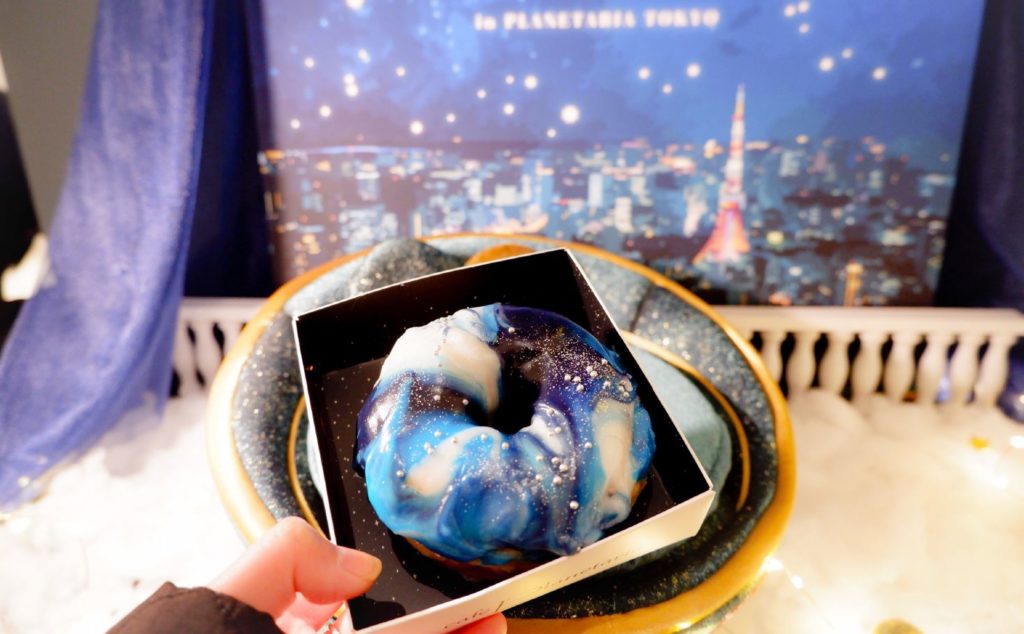
All in all, it was a heart-warming and a truly special experience. I definitely
recommend it— especially for an astrophile like myself. My advice when
visiting for the first time is to book your tickets online— that way you can
make sure that you have a good seat and even enjoy their bead cushion
seating. I also recommend being at the waiting area at least 5 minutes before
the show starts.
Finally, just outside the theater, you will find Cafe Planetaria and their souvenir shop where you may buy soft serve ice cream, donuts and astrology-related items such as necklaces and bath bombs. Before you leave, sure to stop by, and bring a piece of the galaxy back to your own home.
All images for this article were provided by Zygel Doll Jamelano.
Top photo: Element5 Digital on Unsplash
Being an Assistant Language Teacher or ALT in Japan can be (and has been) an incredibly rewarding career. When you first start out though, it can feel like a daunting task, even if it’s not your first time being in the country. Other than the obvious language barrier, there are cultural and curriculum-based differences that can leave first-time teachers feeling lost. With that being said, here are five tips from an experienced ALT on how to go about the job and become the best teacher you can be!
Be Professional
This may seem like a no-brainer, but be wary. Professionalism in Japan could be different from your own home country. It is also an extremely important part of the Japanese workplace.
Be early, be prepared, and be cordial. Make sure to ask your employer and your higher-ups at your school or schools what they expect from you and what is considered acceptable. While you don’t need to wear a suit every day like the folks on the left, be prepared to carry yourself like a pro- you are one!
Be Flexible
This tip applies to your life inside AND outside of the classroom. It’s a little more cut-and-dry for the classroom setting. Your lessons or even the Japanese teacher’s lessons won’t always go as planned, you have to be ready to compensate for that. Keep a handful of games and activities that can be adjusted to any situation on standby just in case.
Outside the classroom, however, being flexible becomes more complicated. You need to be ready for situations to arise that you’re not accustomed to. You might say something that could unintentionally offend someone, or vice-versa. In those moments, it’s important to keep your emotions in check and think logically.
Be Approachable
Part of being an ALT is being an ambassador to your country and in some ways, every country outside of Japan. People are going to want to talk to you, especially if you are living and teaching in a small town. The people who approach you will be understanding if you can’t speak Japanese, but everyone understands body language and facial expressions.
If you look uncomfortable or look like you’re trying to avoid them, they will know. They will also talk to other people in the town about their experience with you. News travels fast in a small town, and you’re most definitely a topic of conversation. With that in mind, smile. Be friendly. Try to communicate. The effort in and of itself goes a long way.
Be Studious
Japanese people love it when you know things about their language, history, and culture. Due to Japan being an island nation with a proportionately small population of foreign residents, Japanese people will rarely have the opportunity to interact with a non-Japanese person concerning their own culture on any deeper level.
Watch some anime and read some manga, especially if it’s popular. Your students will love you for it. Watch some popular Japanese TV programs and familiarize yourself with popular Japanese comedians, bands and sports teams. Their parents will love you for it. Learn some of the language and the history. Everyone will love you for it.
Be Adventurous
Very few people from abroad will visit Japan in their lifetimes. As an ALT, you not only have the opportunity to do so; you’re getting paid to live there! Take advantage of it. Eat the food, swim in the ocean, go to the festivals, go to the onsen, TRAVEL. Say “yes” to as many things as you possibly can.
Japan has a lot to offer, and it would be quite a shame to not take advantage of the opportunity that being an ALT presents to experience as much as you can. I guarantee you will become a better, more well-rounded person for doing so.
Ready to become an Assistant Language Teacher yourself? Get the ball rolling today with Borderlink!
Photo credits:
Top photo: Element5 Digital on Unsplash
All other content (text) created by the original author and © 2021 MUSUBI by Borderlink
Top photo: Jeremy Lam on Unsplash
Spotlight On is a series where we provide a brief glimpse at the 47 Prefectures of Japan.
Okayama Prefecture
Located to the west of Hyogo Prefecture and part of the Chūgoku region, Okayama is known as the ‘Land of Sunshine’, owing to a local belief that it gets more sunny days than rainy ones. Famous for rural landscapes, ancient castles and numerous museums, it nonetheless has its share of major urban areas, particularly the major center of Okayama City.
Okayama boasts Korakuen, one of Japan’s three greatest gardens, and a must-see spot. Right next to it is Okayama Castle, considered one of the 100 best castles in Japan. Other things Okayama is famous for include its denim industry, Hinase Kakioki (oyster okonomiyaki) and its connections to the folk hero Momotaro (with Megijima to the south being the inspiration of the mythical Onigashima).
The beauty and variety of Okayama’s scenery is captured below:
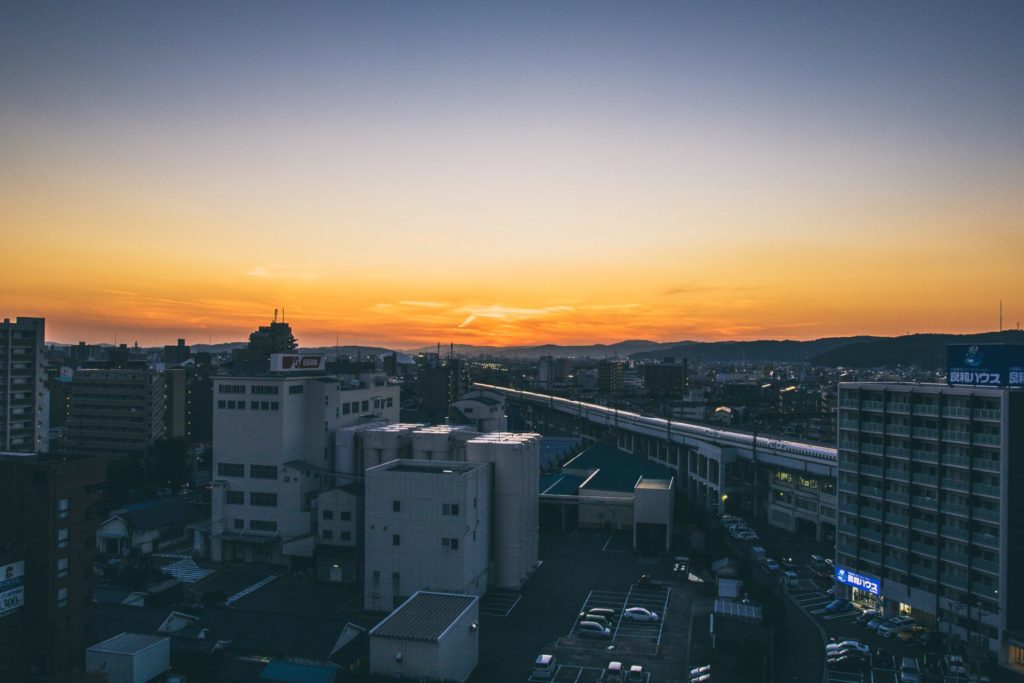
The sun always rises (and sets) in Okayama Prefecture. Photo by Kida Toshiki on Unsplash

A bridge in Kurashiki’s Bikan Historical Quarter. Photo by Masahiro_Yoshizawa
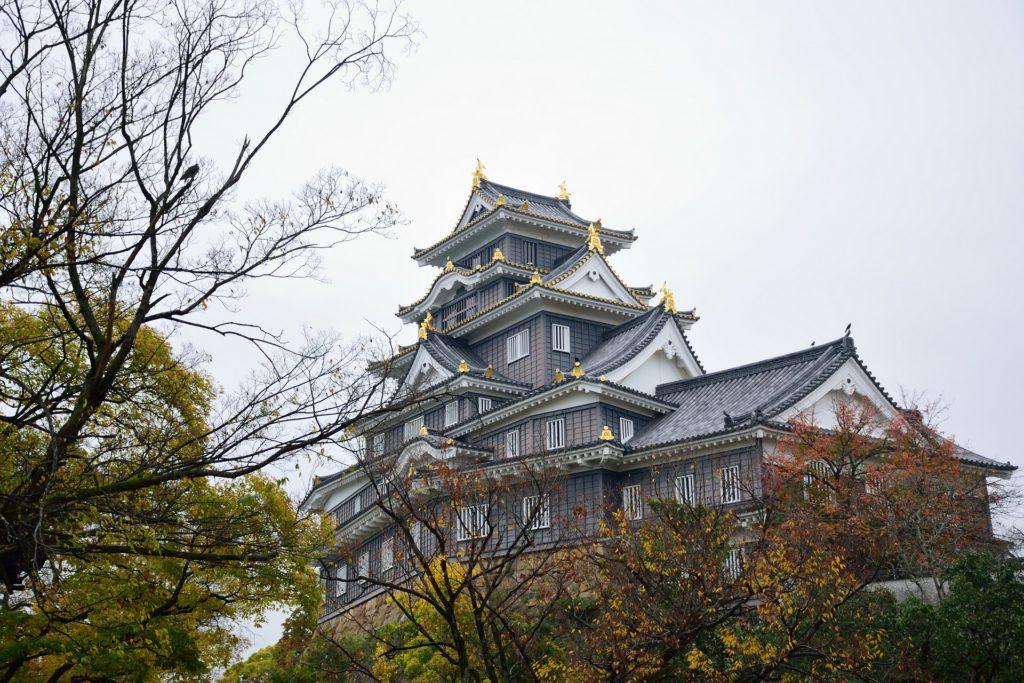
Okayama Castle. Photo by siamkop
Go Beyond
For more about interesting sights to see there, see our previous articles about Okayama on MUSUBI!
Top 5 Sights to See in Okayama
At a Glance: 3 Cool Spots in Okayama City
Interested in making Okayama your next destination? Read all about working as an ALT today!
Photo Credits:
Top photo: Jeremy Lam on Unsplash
All other photos used in this article are free-to-use under the Unsplash and Pixabay license. See the link under each one and be sure to follow the original photographers!
All other content (text) created by the original author and © 2021 MUSUBI by Borderlink
Top Image: ” CASA-DRINK BAR ” by Tokotoko licensed under the Creative Commons Attribution-Share Alike 3.0 Unported license (CC BY-SA 3.0). No changes or alterations were made. Wikimedia Commons Link
When it comes to eating in Japan, your options are almost endless. Ramen stands, conveyor belt sushi, convenience store lunchboxes and rice balls, fancy restaurants, western-style fast food, curry of all kinds and even home cooking if you’re feeling adventurous. But when you really want to experience the true brilliance of Japanese cuisine, you go to a family restaurant.
It might not seem like the most obvious destination. Traditional architecture and atmosphere? You won’t find it here! Local delicacies unique to this part of Japan? Look somewhere else, pal! High-class upper-crusty cuisine that would please even the most discerning of patrons? Get outta town! Family restaurants (or ファミレス) are where you go when you want a comeback to the mantra of “you can have it fast, you can have it cheap, you can have it good, but you can’t have all three”. Because here, you can.
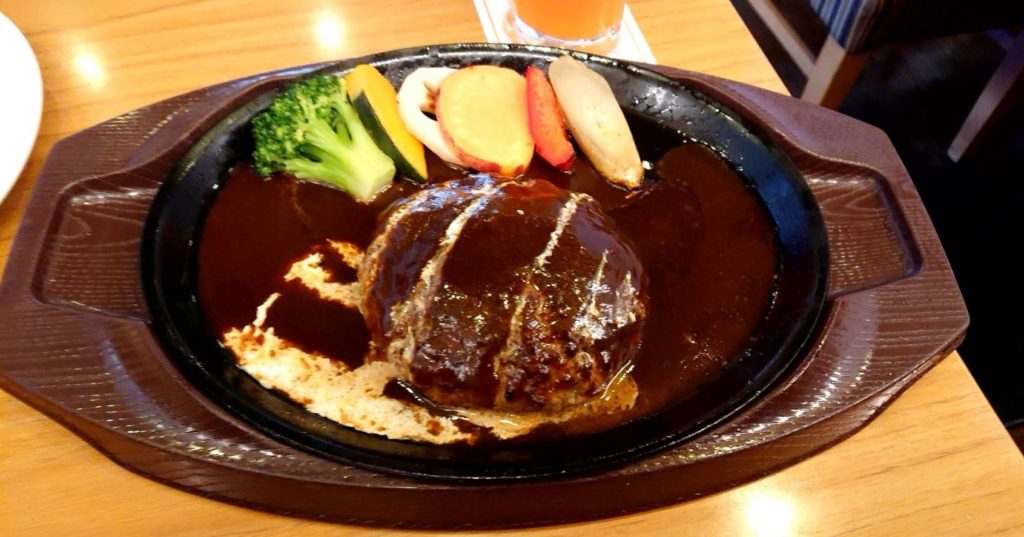
Photo Credit: 経済特区 licensed under the Creative Commons Attribution-Share Alike 4.0 International license.
A family restaurant is essentially any chain diner that provides booth seating, low-price meals or à la carte dishes, and the all-important drink bar. There are many different kinds, some associated with a particular cooking style (Chinese at Bamiyan or Italian at Saizeriya) while others have a more generic theme of “a steakhouse” (Bikkuri Donkey, COCO’s, etc.) And some are American chains transplanted and adjusted for the Japanese market (Big Boy and Denny’s). Variety is the name of the game at all of them though, and it’s just as easy to find a decent hamburg steak at Saizeriya as it is elsewhere.
“Decent” being the operative word, as the quality of food at family restaurants tends to fall in the range of “good enough” to “actually quite delicious”. It’s not going to win anybody any Michelin stars, but you can feel pretty safe trying everything and usually still walk away satisfied- Saizeriya’s escargot is a particular favorite of this writer, and the one-person pizzas might not look like much but they still hit the spot.
But hold up- what’s all this about hamburg steak? Many steakhouses in Japan still have the more conventional sirloin or ribeye steaks (and indeed, they’re usually among the pricier items at family restaurants) but it’s these sauce-glazed bun-less hamburger patties that make up the true meat of the menu. Often served alongside veggies and two or three thick potato fries, they are synonymous with family restaurants and if you haven’t eaten one at one of them, you may have had one in a convenience store meal or even at school.
For those from the US, the closest equivalent is probably a Salisbury steak. It’s not a perfect match, but it might give you a better idea of how it differs from the usual image of “a steak”. These hamburg (ハンバーグ) can be served a variety of ways, including topped with tomato sauce, diced radish or served with curry. Perhaps our favorite version is hamburg steak stuffed with melted cheese. Not recommended for those on a diet, but delicious? You better believe it.
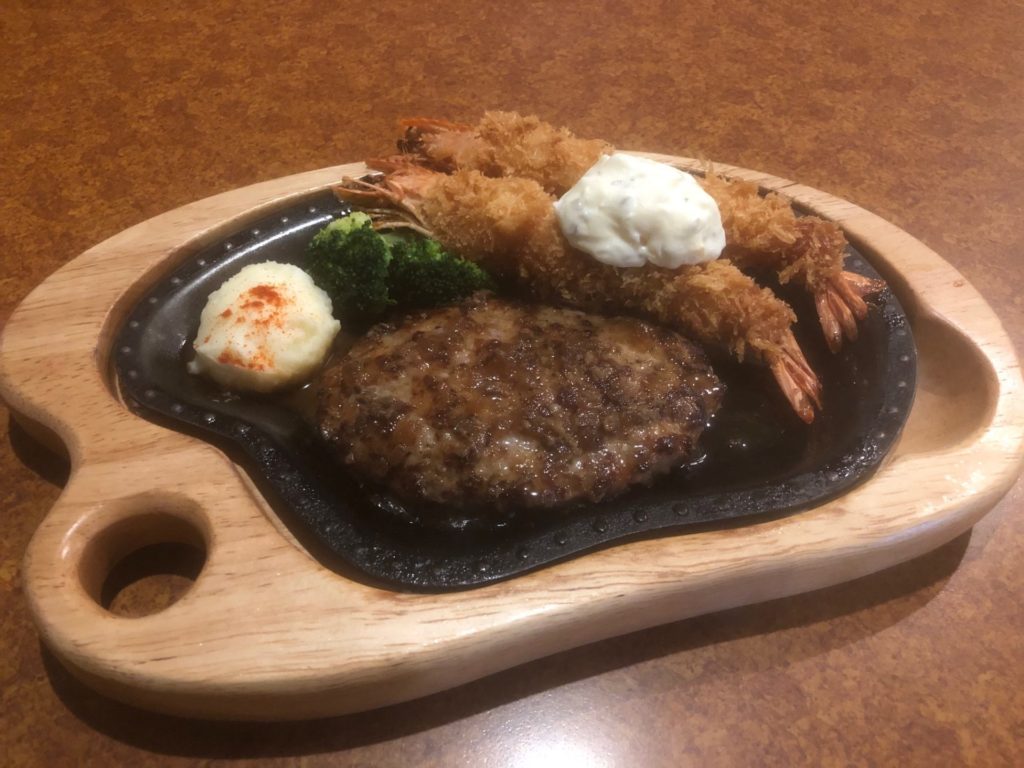
A typical family restaurant meal depends on where you go and how hungry you are. You can order a variety of items off the menu or go with more of a set meal such as the aforementioned hamburg steaks, salads, sandwiches, curry, pasta, pizza, and combinations (this writer’s other favorite: hamburg steak and chicke nanban). Even that usually has options to choose from, such as adding some fried shrimp to go along with your steak. You can add ‘sets’ with soup, salad, rice, bread, or some combination of the above to your meal. And of course, there’s the drink bar.
The drink bar is essentially Japan’s version of free refills. While a rarity (if not impossibility) to find in most fast food joints here, the family restaurants have you covered. Order use of the drink bar with your food (usually around 300-400 yen or less per person) and go wild. You have your choice of sodas, teas, ice coffee, etc. The glasses are small, but the refills are endless! Recently some places even allow you to mix in different fruit syrups for exciting and unorthodox new combinations. Lemon cola, melon ice tea, etc. Soup bars are also increasingly common, and the drink/soup bar combo is great for the hungry diner.
And if you’ve still got room left, there’s a variety of desserts both simple and grandiose. From a basic slice of chocolate tart or vanilla ice cream to towering parfaits that are nearly a meal unto themselves. The mint parfait we had at COCO’s last month seemingly had everything save for the kitchen sink- cotton candy, whip cream, macaroons, mint sauce, ice cream, chocolate brownies, coca flakes, and yet more layers of whip cream and mint sauce. Many family restaurants have a consistent ‘grand menu’ as well as rotating monthly specials. If mint isn’t your thing, we’ve seen strawberry and mango equivalents of the below.
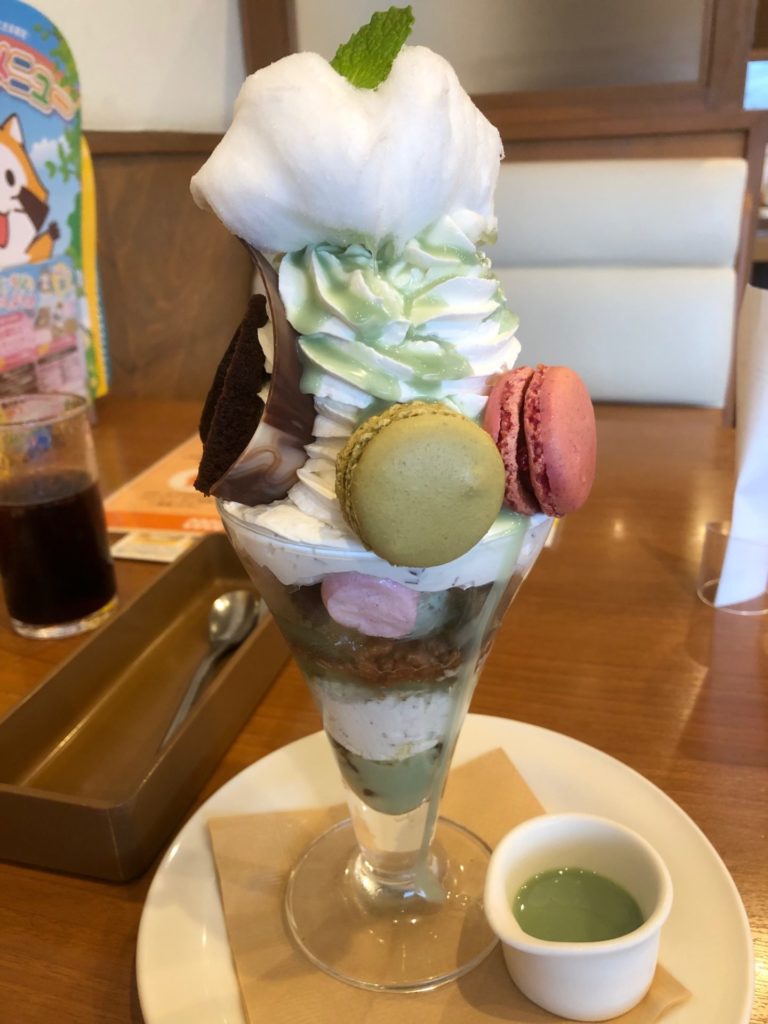
Family restaurants are havens for the weary traveler on a sightseeing excursion or busy day out. They offer cozy atmosphere and a relaxed pace (unless there’s a lot of people waiting at the entrance, patrons are generally encouraged to take their time and order as much as they like). Many establishments have a last order time late into the night/early into the morning, or just stay open 24/7. Missed the last train home? Spend some time at the nearest family restaurant with delicious snacks, continuous refills and a comfy booth to keep you rested until that first morning train.
And, if you know your way around the menu, you can walk out of any establishment with a satisfying meal for a satisfying price. This makes family restaurants excellent for when you want to treat yourself on a weekend without necessarily breaking the bank. Or, if you’ve got some friends with you, a great place to sit and chat while snacking on various dishes.
Just remember to save room for dessert. It’s worth it!
Photo Credits:
Top Image: ” CASA-DRINK BAR ” by Tokotoko licensed under the Creative Commons Attribution-Share Alike 3.0 Unported license (CC BY-SA 3.0). No changes or alterations were made. Wikimedia Commons Link
1 – ” ガスト西川口駅前店のプレミアムチーズインハンバーグ(20201206) ” by 経済特区 licensed under the Creative Commons Attribution-Share Alike 4.0 International license (CC BY-SA 4.0) No changes or alterations were made. Wikimedia Commons Link
Additional photos (2, 3) were provided by the author, used with permission.
All other content (text) created by the original author and © 2021 MUSUBI by Borderlink
Top photo: makoto.hさん on PhotoAC
Just about 40 minutes from Tokyo, Kawagoe City in Saitama Prefecture makes for an incredible day trip for travelers. For those living in nearby areas such as Tsurugashima, Ogawa, Kawajima or Higashimatsuyama, it’s a great place to take family, friends or just yourself on the weekend.
Passing through this small city is like taking a leisurely stroll through the set of a samurai movie. Kawagoe has earned the title “Little Edo” for having managed to preserve both the cultural and architectural features of the old Edo Period (1603-1868). Edo was the old name of the country’s capital until it was renamed Tokyo by Emperor Meiji when he moved the capital from Kyoto in 1868.
The best seasons to visit are the spring or fall for the more temperate weather and the beauty of the cherry blossoms or falling leaves. Make sure to grab a copy of the Kawagoe Tourism map from the Tourism Information Counter at either of the city’s major train stations. I also highly recommend buying the Kawagoe discount pass which saves you money and time. You can buy it Tobu Tojo Centre in Ikebukuro station or at Kawagoe station.
Here are just a few of the standout sights (and tastes!) of Kawagoe:
Kurazukuri-no-Machinami (Old Warehouse District)
Long ago, the Kurazukuri, or clay-walled warehouses, were used to hold rice and other supplies back when Kawagoe was a commerce center. These days, the warehouses have been converted into souvenir shops, restaurants and cafes, but the traditional architecture remains. Take your time to wander around, browse the items for sale or stop for a refreshing drink.
This area is perhaps the main point of interest in Kawagoe. You could spend a couple hours here depending on how thoroughly you explore the area. You can even get a lift in a jinrikisha (pulled rickshaw) allowing you to cover more ground. For ¥6,000, you can get a 1-hour tour all around “Little Edo”. Or, if you’re looking for something more leisurely, you can even get dressed up in kimono and other traditional clothing to “step back in time” yourself!
Toki-No-Kane (Bell of Time Tower) and Yakushi Shrine
Within the Old Warehouse District there is a 16-meter tall bell tower that has become the symbol of Kawagoe itself. Long ago the bell was rung every hour to mark the time. Now, it still sounds four times a day. There’s a particularly nice sweets café called Fukuroya which sells bell-shaped rice cakes embossed with an image of the tower itself.
Next to the bell tower is the Yakushi Shrine. People still come here to pray for good harvests, financial luck and and recovery from various illnesses. If you want to offer a prayer, first cleanse your hands and mouth at the chouzubachi (water basin) nearby. It is an essential part of the prayer ritual. Ring the bell once, drop a coin in the saisenbako (wooden box), bow your head twice, and clap your hands twice followed by another bow. This is standard procedure at Shinto shrines, so if you’re well-traveled around Japan you should be used to it.
Mochi Balls & Sweet Potatoes
Imonokura is a local well-known sweets shop that sells mochi balls skewered on bamboo sticks dipped in a sweet soy syrup. Extremely popular, long lines often form outside the shop. The sweet potato onigiri and sweet potato ice cream sold in the area are also popular.
Easy to cultivate, sweet potates became a staple in Japanese cuisine and Kawagoe was known as the biggest source of food after the war. These days, Kawagoe remains famous for its sweet potatoes, so much so that sweet potato tours are conducted during the harvest season (mid-September to early November). If you’re going to take a trip to Kawagoe, a must-try item is the osatsu chips, a specialty of Koedo Osatsu-an, located neat Toki-No-Kane. Large fried slices of sweet potato, they are very crispy and can be enjoyed with sauces such as salted butter.
Kashiya Yokocho (Penny Candy Lane)
Several shops sell traditional Japanese sweets at the northern end of the Old Warehouse District. For tourists, it is the perfect spot to try various Japanese confectionaries. One of the most fun things to do in Kawagoe is to “eat your way” around the areal sampling various candies and sweets.
Kawagoe Hikawa Shrine
Kawagoe’s Hikawa Shrine is famous for its bright orange torii (traditional archway or gate) which stands at 15 meters tall. It’s also famous for its shrine houses, where five Shinto deities dwell. Two of them are said to be a married couple, making the shrine popular among those who seek life partners and a harmonious married life.
At the back of the shrine are two huge zelkova trees that are said to be the personification of the married couple. During summer there’s a festival known as Enmusubi Furin. Furin are wind chimes, often associated as a sound of summer in Japan. You can see many hung up all around the shrine during this time.
Kawagoe Castle Ruins (Honmaru Goten)
Kawagoe Castle is often considered one of the 100 best castles of Japan and among the seven best castles of the Kanto Region. Built in 1457, the Honmaru Goten or the innermost defense building, is the only remaining structure of the original Kawagoe Castle. It is the closest castle to Tokyo to be accessible to visitors, as Edo castle is now the Imperial palace, and largely inaccessible.
Kitain Temple
Kitain Temple is a Buddhist temple with a very long history, and notable for being part of the original Edo Castle. Aside from the various buildings on the temple grounds, one of the most popular features of the temple is the 500 Rakan statues. Created by the monk-artist Shoun Genkei, their facial expressions are all unique.
In the fall, you can see vibrant leaves changing colors, or the beautiful cherry blossoms in spring. The main area is open to public, but if you want to explore further, know in advance that you will need to pay a small fee.
That’s a wrap for this short travel guide to Kawagoe! You’ll be impressed with the well-kept architecture and commitment to aesthetic that runs throughout the city. There is even a Starbucks with the unique, traditional architecture of the area that allows it to blend in with its surroundings. If you’re looking for a blast from the past in the present day, you can’t go wrong with a daytrip back in time to Kawagoe!
Photo Credits:
Top photo: makoto.hさん on PhotoAC
Previously-used photo courtesy of Shamosan on pixabay.com
All other content (text) created by the original author and © 2021 MUSUBI by Borderlink
Top photo: Philippsaal on Pixabay
It cannot be stated enough how strange the past year has been, and how uncertain the future still is. However, this does not mean we can’t enjoy ourselves and, if we’re lucky enough to be here, see what Japan has to offer. It is easy to forget that some of the most beautiful and gorgeous places can be a five-minute walk away.
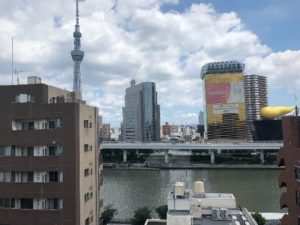 Even with large cities like Tokyo and Osaka undergoing a “state of emergency”, this is still nothing close to a complete lockdown and many things are still open and running. Although this is good news economically, the spread of COVID-19 is still a concern and non-essential travel between prefectures is still largely discouraged.
Even with large cities like Tokyo and Osaka undergoing a “state of emergency”, this is still nothing close to a complete lockdown and many things are still open and running. Although this is good news economically, the spread of COVID-19 is still a concern and non-essential travel between prefectures is still largely discouraged.
It seems like a waste to not pack suitcase and go out and see what Japan has to offer, but you might not need to travel that far. Japan has a rich and interesting culture where natural beauty coexists with modern living. No matter where you live in Japan, you can find the beauty of this country anywhere.

The four seasons most definitely do exist here in Japan, and with each season comes a distinct change in color and atmosphere. One of the most well known sights of spring is the bright and bountiful cherry blossoms. Traditionally enjoyed with friends and families during Hanami (花見), simply translated as flower viewing, these flowers can still be enjoyed alone while out on a walk.
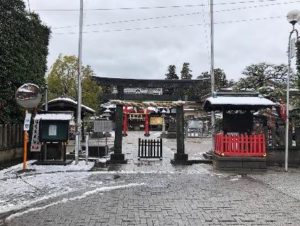 The great thing about cherry blossoms in the spring is that there are an abundance of them across Japan, and even different kinds to enjoy. You don’t have to go to a famous or well-known park to enjoy them, most local parks will have these tree blooming.
The great thing about cherry blossoms in the spring is that there are an abundance of them across Japan, and even different kinds to enjoy. You don’t have to go to a famous or well-known park to enjoy them, most local parks will have these tree blooming.
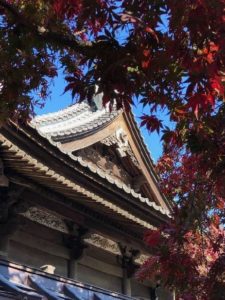 Another well-known Japanese image would be the traditional shrines. Japan is known as the country with a million gods, and these shrines pay homage to all of them. When opening up Google map, you would be hard-pressed to not find a local shrine (or Buddhist temple) nearby.
Another well-known Japanese image would be the traditional shrines. Japan is known as the country with a million gods, and these shrines pay homage to all of them. When opening up Google map, you would be hard-pressed to not find a local shrine (or Buddhist temple) nearby.
Some are bigger than others, but all have a distinct beauty to them. Whether it’s in the freezing temperature of winter, or the cool wind of autumn, their presence radiates the tradition and culture that is preserved in their walls.
Japan has so much to offer, and sometimes it feels that everything is so far away. But I realized that if I take a good look around where I live, I can appreciate the area a lot more. Taking the time to explore your local streets and parks can prove to be more fulfilling than a trip to a different prefecture.
Tomorrow is promised to no one, but we can only hope that in the near future, something resembling ‘normalcy’ – or the life we knew before the early months of 2020 – will return. For the time being though, taking a stroll through my city is the greatest adventure I can look forward to.
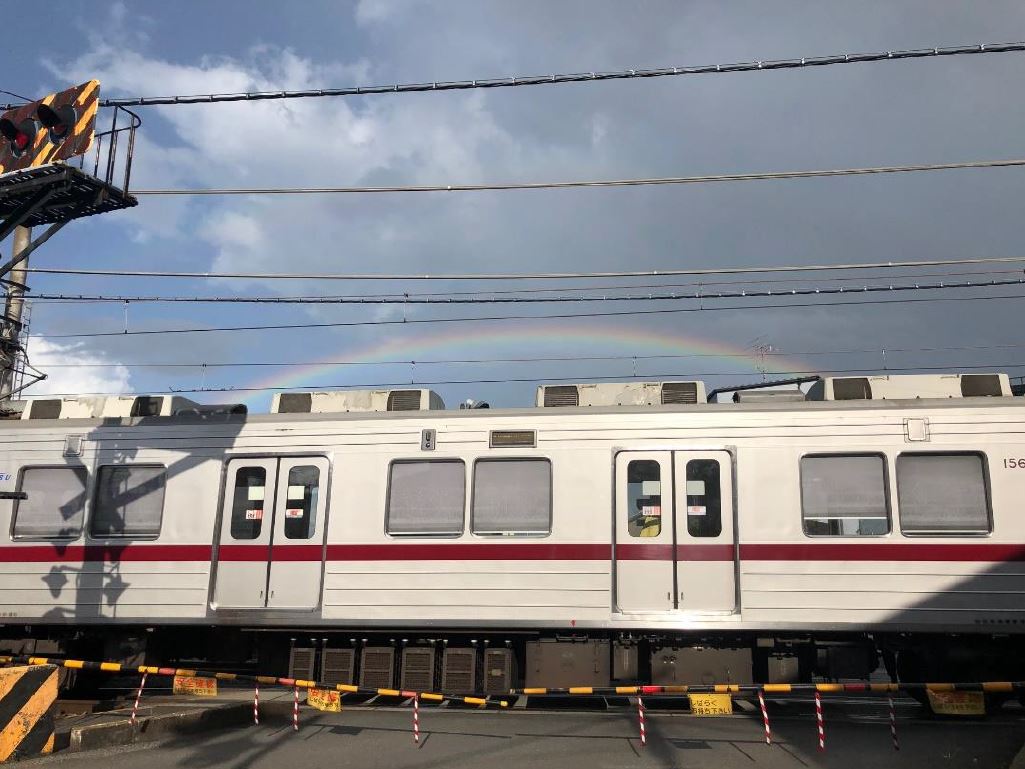
Want to look forward to your own adventure?For more information, read all about the job of an ALT!
Photo Credits:
Top photo: Philippsaal on Pixabay
Additional photos were taken by the original author, used with permission
All other content (text) created by the original author and © 2021 MUSUBI by Borderlink
Top Image: NaoYuasa via Pixabay
You know it, you love it: Ramen.
One of Japan’s signature foods, the delicious and hearty dish has been around since at least the 19th century. When Japan ended its period of isolation, many Chinese immigrants settled in the Yokohama area and established restaurants to cater for fellow immigrant workers.
At first ramen was called “nankin soba”, with the word “ramen” being a Japanese transcription of the Chinese word lamian (拉麵). Despite that, the dishes are actually different, and what we know as ramen shares more in common with a Cantonese noodle soup. The latter half of the 20th century is when ramen truly gained the identity it has today, and many regional variations sprang up.
There are many kinds of ramen in Japan, each with their own unique flavors, combinations and innovations. Ramen consist of a soup base, wheat noodles and toppings such as chashuu (sliced roasted pork fillet), egg or menma (bamboo shoots). The soup broth is what truly makes ramen great.
There are three main soup flavor groups: tonkotsu (pork bone broth), shoyu (soy sauce) and shio (salt) flavors. From there, there are a myriad of other varieties and variations. Here are some lesser-known ramen combinations that are among the tastiest hidden treasures in all of Japan.
牛骨ラーメン – Beef Broth Ramen
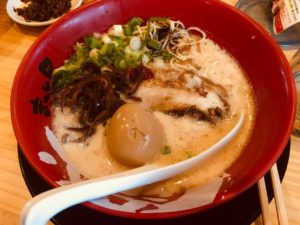 This ramen is similar to the very popular tonkotsu ramen. Whereas that uses pork, this ramen uses beef bones as the base for the broth, giving it a very strong meaty taste that is less fatty than the pork broth variety. Despite the use of beef, this ramen is most often enjoyed with chashuu. However, for those seeking to keep to Halal or Kosher diets, the chashuu is optional.
This ramen is similar to the very popular tonkotsu ramen. Whereas that uses pork, this ramen uses beef bones as the base for the broth, giving it a very strong meaty taste that is less fatty than the pork broth variety. Despite the use of beef, this ramen is most often enjoyed with chashuu. However, for those seeking to keep to Halal or Kosher diets, the chashuu is optional.
ラーメン二郎 – Jiro Ramen
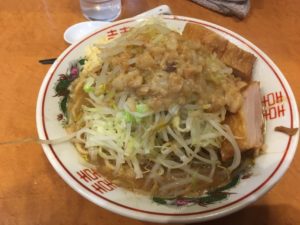 Jiro-style was first created in Tokyo in 1968 and proved popular with university students. You can read all about that story here.
Jiro-style was first created in Tokyo in 1968 and proved popular with university students. You can read all about that story here.
This style of ramen usually contains a salty shoyu and tonkotsu soup base with stick noodles and a mountain of moyashi (bean sprouts), cabbage and fatty pork chunks. Famous for large portions and an extremely high calorie count for one average serving, Jiro-style ramen is for hungry diners only!
味噌バターラーメン – Miso Butter ramen
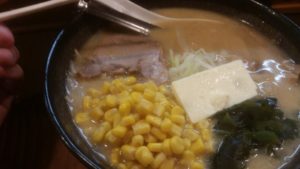 Developed in Hokkaido in 1965 and now a major tourist magnet in the region, this ramen is a miso-based ramen, its lightly sweet and tangy flavor has been combined with butter. This creates a rich, buttery (and high calorie) soup, often served with corn, moyashi and thick noodles. This ramen is perfect for the cold winters of Hokkaido.
Developed in Hokkaido in 1965 and now a major tourist magnet in the region, this ramen is a miso-based ramen, its lightly sweet and tangy flavor has been combined with butter. This creates a rich, buttery (and high calorie) soup, often served with corn, moyashi and thick noodles. This ramen is perfect for the cold winters of Hokkaido.
カレーラーメン – Curry Ramen
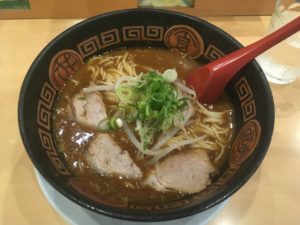 Curry ramen is a fusion of two wonderful worlds ramen and a curry. Also sharing an origin in Hokkaido in 1965, albeit one in dispute: the city of Sanjo claims to have invented the style decades before.
Curry ramen is a fusion of two wonderful worlds ramen and a curry. Also sharing an origin in Hokkaido in 1965, albeit one in dispute: the city of Sanjo claims to have invented the style decades before.
Tonkotsu ramen is usually used in this type of ramen for its strong, robust, meaty flavor to help give a unique taste to the thick curry soup.
There are many reasons as to why one would want to come to Japan. Exploring the diverse combinations of delicious ramen and their toppings is a good enough reason for wanting to visit and explore all over the country. So go on, gotta taste ‘em all!
Photo Credits:
Top Image: NaoYuasa via Pixabay
Additional photos were provided by Anthony Matecki, used with permission.
All other content (text) created by the original author and © 2021 MUSUBI by Borderlink
Top photo: Phil Hearing on Unsplash
MUSUBI presents the conclusion to a two-part essay on one of the most useful but at times confusing parts of learning Japanese- the loanwords.
Part 2: But does this Viking include American Dogs?
Twelve years after I arrived in Japan, I still struggle with the language while my two hyperactive kids can switch languages on a dime, like they have a built-in
select-a- language-button hidden on the back of their heads.
As all languages do, Japanese also evolves. Some new terms pop up; others
become almost archaic; and new words from overseas are adopted and adapted.
Compare newspapers or reading materials from ten years ago to those from today, and you’ll see that there are more English or foreign words being incorporated and used now. Most of them have taken new form, meaning and pronunciation. So much so that locals might not even recognize them when spoken by a native speaker.
I spent the first seven years here in Japan working at an international hotel with people from around the world, and English was spoken most of the time. However, being in Japan, Japanese would be used as well. From that experience, I learned that there is truly no escaping from loanwords, as many make their way into the language of hospitality. Some of the words I learned included:
1. Front (フロント) refers to the ‘front desk’ or ‘front office’.
2. Claim (クレーム) is a ‘complaint’ or acting of complaining (in a customer service setting)
3. Viking (バイキング) comes from ‘Viking-style setting’, but refers to ‘a buffet’ or ‘smorgasbord-style’ meal.
4. Cider (サイダー) actually means ‘soda pop’ or ‘a carbonated drink’.
5. Driver (ドライバー) can mean the same, but can also refer to ‘a
screwdriver’.
6. Orai (オーライ) from the word ‘alright’. Valets or hotel staff would usually say it when you are backing up your car which just simply means ‘it’s alright’ or ‘it’s safe’.
7. American Dog (アメリカンドッグ) which refers to ‘a corn dog’.
Nowadays, I work as an ALT in elementary schools. Working with children keeps me young at heart; it’s fun and exciting. As cliché as it sounds, it’s true: everyday is a learning experience. Even in schools, you would be surprised at how students and teachers alike use loanwords.
As a teacher, sometimes I get the itch to correct every bit of it, but then I realize that these words are not truly English anymore. They have been adapted and assimilated. This could probably be compared to how we use some Japanese words abroad. Some shops in the US will redundantly use ‘Japanese Wagyu Beef’ when wagyu already means ‘Japanese Beef’ or ‘kombucha tea’ when cha already means ‘tea’.
Here are some surprising loanwords that I’ve encountered in school:
1. Cunning (カンニング) actually refers to cheating. I would often hear teachers say “kanningu wa dame” which rough translates to ‘do not cheat’.
2. Almighty (オールマイティ) for English speakers means ‘godlike’, but in Japanese means ‘multi-purpose’ or ‘versatile’.
3. Sense (センス) refers to good taste or common sense.
4. Image (イメージ) refers to ‘your imagination’ or how you visualize
something in your head.
5. High Tension (ハイテンション), rather than meaning tense means ‘excited’, ‘hyperactive’ or ‘overly enthusiastic’.
6. Print (プリント) from the word ‘print’ is not a verb here. It refers to ‘printed hand-outs’.
7. Trainer (トレーナー) can mean one who trains, but it also refers to a ‘sweat shirt’.
8. Uinaa (ウインナー) comes from “Wiener” and refers to any type of sausage or frankfurter, as well as the city of Vienna and anything from it (i.e. Vienna coffee).
9. Hamburg (ハンバーグ) refers to a hamburg steak, which is a little different from a hamburger (and close, but not identical, to a Salisbury steak). ハンバーガー on the other hand is the one that comes with buns.
What I’ve realized over the years teaching English in elementary schools is
that both students and teachers can learn from each other. Children respond well to different means of communication. It could be gestures or using parts of their lingo. Understanding and using these words can help facilitate smoother communication.
As an ALT, we are not only teachers of language, we are also ambassadors of culture. The more you communicate, the more opportunity you have to educate; to open their minds to a bigger world out there while opening your eyes to theirs.
Ultimately, for those learning Japanese, loanwords may at times prove useful allies as we try to navigate daily conversations. They may also prove frustrating when they end up meaning something very different than what we’re used to. But as I said, in a way, they have transcended beyond being English or the other languages they originally came from to become something wholly Japanese. These ‘false friends’ of ours have ended up becoming as easy or hard to use as any other word.
Ready to experience your own ALT adventure? For more information, read all about the job of an ALT!
Photo Credits:
Top photo: Phil Hearing on Unsplash
All other content (text) created by the original author and © 2021 MUSUBI by Borderlink

